
|   |

|   |
 e-mail: sunilkothari1933@gmail.com Shantha Ratii Initiatives presented Sparks Photos courtesy: SRI Studios November 21, 2020 Shantha Ratii Initiatives presented the two day Singapore International Dance Day Festival SPARKS on 6th and 7th November 2020 at the SRI studio. It was conceptualized, created and choreographed by Shantha Ratii in collaboration with Singapore Indian Fine Arts Society (SIFAS), Sheng Hong Arts Institute (SHAI). It was sponsored by National Arts Council of Singapore, A.R.T.S Fund, and SG Cultural AnyWay. 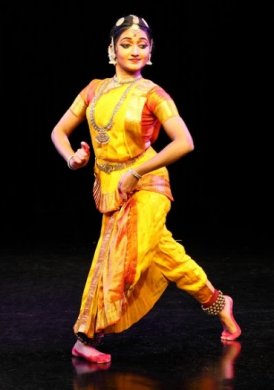 Ashmita Jayaprakash On the first day, Pushpanjali was presented by Bharatanatyam dancer Ashmita Jayaprakash. She evoked the iconic image of Lord Ganapati in a prayer 'Suprasiddha Gajavadanam Gananatha, Prasannamukha Kamalam', with epithets of 'Vighnarajam, Sakalashastra karakam, Siddhi Buddhi kayakam, Tattvagunaposhakam, Sarvakalavardhanam Parvapautra Shivasutam'. Each epithet was danced with hand gestures becoming the simile and metaphors, with graceful swaying movements. The nritta along with the svaras, musical solfa notes was alluring. The teermanams were executed with perfection. The treatment of expressions, abhinaya and nritta alternating reminded one of a format of a varnam. The pirouettes were in perfect sync. 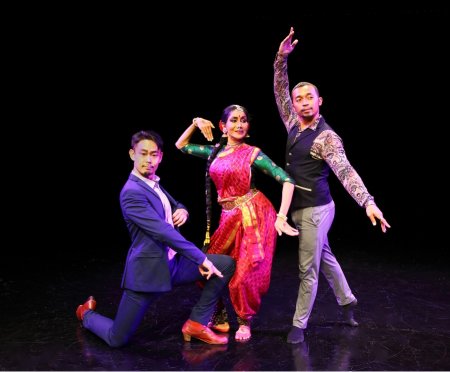 Traversing The second item titled 'Traversing' saw Shantha performing Tarangam on the rim of a brass plate with two male Chinese dancers adapting their dancing to the mnemonic syllables of mridangam. One of the male dancers executed like a tap dance to the mnemonics, the other moved in a freewheeling contemporary style. The fluidity of movement was engaging and their covering the stage in a circular manner around Shantha standing on the brass plate, looking like Goddess Lakshmi emerging from ocean, created beautiful visuals. 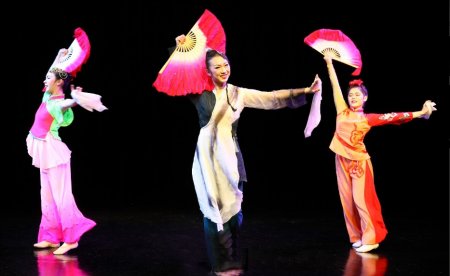 The female dancers with their large fans waving walked gracefully. Among them 16 year old dancer Shang Huy drew attention for her adaptability to another dance medium, imitating movements in consonance with Kuchipudi aligning arm movements, which were executed in diagonals, resonating the Kuchipudi impact. The abhinaya was seen in opening of lotus by Shan Huy, the rippling water by another senior dancer, the third dancer waving the large fan giving an impression of Traversing.The handling of the fan, their graceful walk, at times using two fans in both hands, creating dance patterns on the floor, suddenly sitting and getting up gracefully, showed their versatility. At one point, the three dancers danced together and Shantha in the centre wondering what they were doing, with an element of being cheeky, provided humour. In their jumps they used folk dance movemens in harmony. Their swirling a la Kathak to Chinese music was entertaining. Sometimes two dancers would dance pas de deux displaying their joy. 'Mix't Up' with Shantha performing Kuchipudi and two male dancers joining them following arm movements of Shantha's Kuchipudi, to melodious rendering of jatis, dhira na dhira na, often giving impression of a Tillana, and a third male dancer in a jacket shaking his shoulders to complete a teermanam was quite entertaining. The jugalbandi like dance by two male dancers was reminiscent of Kathak jugalbandi, often matching their footwork to sound of the brass plate. The number was choreographed as a cross-cultural interdisciplinary dance without borders. The contemporary dancer Sufri Juwahar and Toshiaki Konno danced along with Shantha, she dancing Kuchipudi and the boys in their own medium. 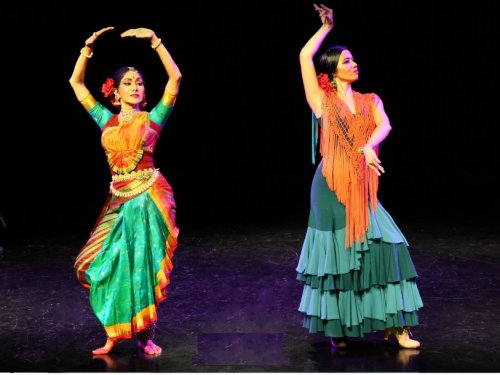 The Kuchipudi and Flamenco duet by Shantha and Flamenco dancer emphasized meeting points with two sets of musicians on either side of the stage. On one side were mridangist Tripunithura Sreekanth, Jocelyn NG Jinghui on violin, Cedric Chin on pipa, and on the other side Ying Ying playing Chinese drum, Riduan Zalani on Malay drum and Manjula Surendra on veena. Shantha's graceful gait in Kuchipudi style and Toshiaki Konno with chin up and forceful walk and swirling skirt in Flamenco style, created an interesting climax. With the Flamenco dancers on either side of Shantha, three of them raised their arms heavenwards creating one more climax. The drums accelerated their pace highlighting the scene. 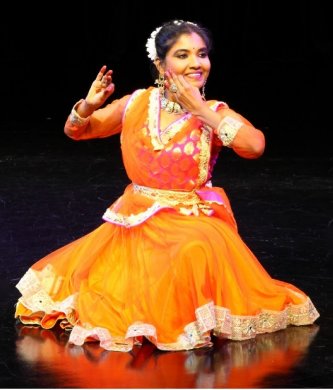 Monishah Sathish Kumar On the second day, young Monishah Sathish Kumar performed to a Rajasthani song dressed in saffron color as mentioned in the song 'Kesariyake rang kar bansari Suhay Krishna' - he is resplendent in saffron colour costume, walks gracefully in quicksilver gait, dancing thunga, thunga, thunga, thunga and he wins our hearts. With him are Radha and the Gopis. They take palta and dance to the kavit, which describes Krishna's adornments; kundal in his ears, tilak on forehead, anklebells on his feet making jhan jhan sound and he enchants playing the melodious bansuri. After the abhinaya number, Monica regaled the audience with tatkar, tode, tukde, in Jhaptaal. And walked her way into the hearts of the spectators with a thai, tat thai, ta thai, tat thai, ta thai, tat thai. She was charming and danced with joy. 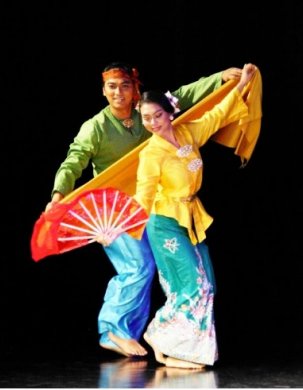 Era Dance Theatre Followed Rama Ja Ria Malay Dance by artists of Era Dance Theatre featuring Dinie Dasuki Bin Osman and Nurul Nursyamin flowing gracefully holding fans, often in sitting postures, getting up quickly, the male dancer throwing a scarf, enticing the female dancers, and two of them dancing together, teasing each other, challenging, clapping, maneuvering the scarf and the fan and spreading joy all around. 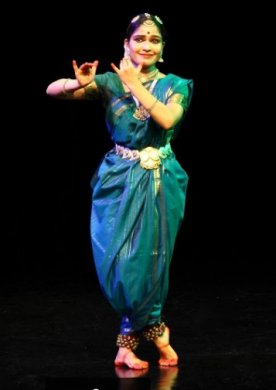 Aarthi Devarajan Bharatanatyam dancer Aarthi Devarajan presented Yadavaraya, Krishna playing flute in Vrindavana, which in spring time has blossomed forth. Radha, Gopi and Madhusudan were dancing together, the gods accompanying them, Narada playing veena, and various gods playing different instruments. The gods from Indralok were watching with the apsaras - celestial dancers. Aravindanayana Krishna, with his eyes like lotus, was caressing cows. He was none else than Keshava reclining on serpent Shesha, captivating the three worlds, Tribhuvana, with magical sound of his flute. To that Krishna, the Gopi offers pranams. Arathi is a seasoned dancer and excelled both in nritta and abhinaya. The finale was in Kathakali, an excerpt from Duryodhanavadham. When Krishna goes on a peace mission to request Duryodhana to avoid war, Draupadi insists that her revenge has to be taken, as she was dishonoured by Dushasana in full view of the court and her five husbands, when her dear friend Krishna had saved her from humiliation. Since she was dragged by her hair in court by Dushasana, she had taken a wow not to tie her hair. 'O Krishna, my dear Sakha, look at my undone hair and take pity on me; punish those who humiliated me. None but you can save me, O Krishna, therefore I do not want peace, but want war where the culprits can be punished and I am avenged.' Shantha as Draupadi enacted the role with great dignity, wearing expressions of tremendous agony, begging Krishna to see that those who insulted her be punished. Kalamandalam Biju, a versatile Kathakali actor from Bhaskar's Arts Academy, played the role of Krishna, who assured Draupadi that she need not worry. 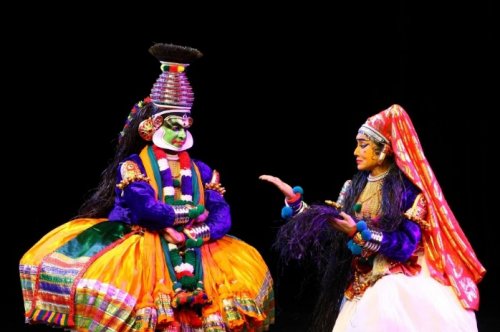 Kalamandalam Biju & Shantha Ratii 'O Draupadi, you are a gem in the Pandava family, Manini kula mauli mani, from a noble birth.' Krishna tells her not to shed tears. 'Let your beautiful face not wilt away like a withered lotus'. The dancing proceeds with gentle kalasam, nritta, by Draupadi. The soft music in Manipravalam songs, in tune with Draupadi's crying is rendered in an appealing manner. 'Mama sakhi, my dear friend, do not lament any more.The due punishment will be accorded'. Chenda playing quickens when Krishna gets angry. The camera close ups are excellent registering the subtle expressions. 'Paripahi maam', Draupadi bows to Krishna who blesses her. Krishna ends the performance in a beautiful kalasam. The well enacted excerpt brought down the curtains of the two day festival. To the credit of Shantha it must be said that she curated the festival with the advantage of her exposure to international and regional cultures, admirably. With her own knowledge of filming, as she has worked with television and produced a documentary comparing Noh and Kathakali styles, Shantha highlighted the expressions where necessary. The entire team work was commendable. She received help from her sister Bhamah Sudharman for makeup and costumes. Camera team of Vicky, Senthil and Harish, production manager Tami Johnsen, lighting by K Kalairasan and Ajay Kumar, direction by Lakshmi Raman Venkat, event coordinator Ashwini More, DOP and editor RU Vivek, brand marketing team Aruna Anantha Sayanam and Menaka Gopalan, all deserve compliments for a successful festival. Compere Anita Kapoor did a good job of introducing the artists, musicians and technical team. The production values were high and professional. The festival can be seen on YouTube. Day 1 Day 2  Dr. Sunil Kothari is a dance historian, scholar, author and critic, Padma Shri awardee and fellow, Sangeet Natak Akademi. Dance Critics' Association, New York, has honoured him with Lifetime Achievement award. Post your comments Please provide your name and email id when you use the Anonymous / blog profile to post a comment. All appropriate comments posted with name and email id in the blog will also be featured in the site. |